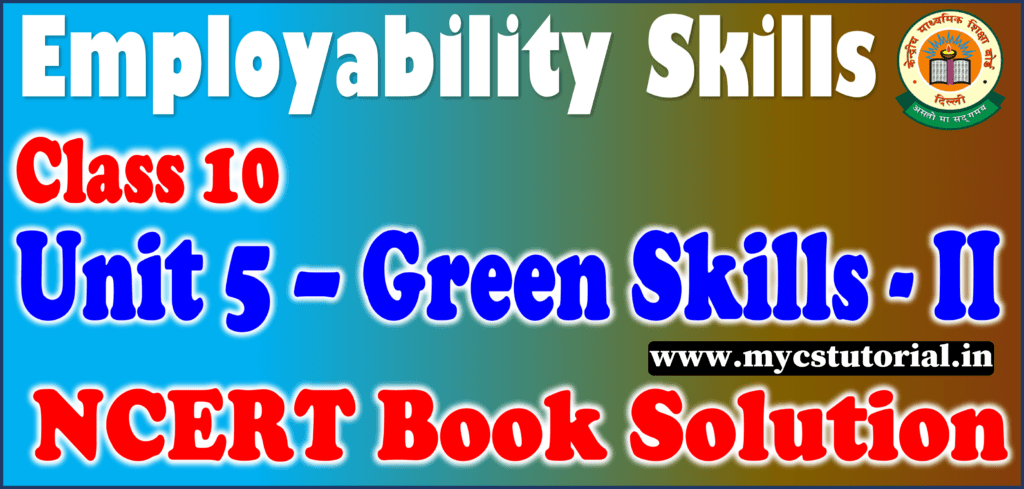Class 10 Employability Skills NCERT Book Solution
Unit 1 – Communication Skills II
Session 1: Method of Communication
Check Your Progress – 01
A. Multiple-choice questions
Read the questions carefully and circle the letter(s) (a), (b), (c) or (d) that best answer(s) the question. (Note: There can be more than one correct choice)
1. Which of the following is NOT an element of communication within the communication process cycle?
(a) Channel
(b) Receiver
(c) Sender
(d) Time
Answer: d. Time
2. You need to apply leave at work? Which method of communication will you use?
(a) e-mail
(b) Poster
(c) Newsletter
(d) Blog
Answer: a. e-mail
3. By which action can senders send their messages?
(a) Gestures
(b) Speaking
(c) Reading
(d) Writing
Answer: c. Reading
B. Subjective question
1. Make a chart highlighting all the methods of communication. Use markers and colours to highlight differences amongst all. [Do it by yourself]
Answer: Methods of Communication are
| Method | Description |
| Face-to-face informal communication | There is nothing better than face-to-face communication. It helps the message to be understood clearly and quickly. Also, since body language can be seen in this case; it adds to the effectiveness of the communication. |
| e-mail can be used to communicate quickly with one or many individuals in various locations. It offers flexibility, convenience and low-cost | |
| Notices/Posters | It is effective when the same message has to go out to a large group of people |
| Business Meetings | Communication during business meetings at an organisation are generally addressed to a group of people. It can be related to business, management and organisational decisions |
| Other Methods | There can be various other methods like social networks, message, phone call for communication, newsletter, blog, etc. |
Session 2: Verbal Communication
Check Your Progress – 02
A. Multiple-choice questions
Read the questions carefully and circle the letter(s) (a), (b), (c) or (d) that best answer(s) the question.
1. Which of the following is an example of oral communication?
(a) Newspapers
(b) Letters
(c) Phone call
(d) e-mail
Answer: c. Phone call
2. What are the types of words we should use for verbal communication?
(a) Acronyms
(b) Simple
(c) Technical
(d) Jargons
Answer: Simple
3. Why do we use e-mails?
(a) To communicate with many people at the same time.
(b) To share documents and files.
(c) To talk to each other in real time.
(d) To keep a record of communication.
Answer: a and b (To communicate with many people at the same time. To share documents and files.)
B. Subjective question
1. List the different types of verbal communication. Include examples for each verbal communication type.
Answer: Different types of verbal communication are-
| Types of Verbal Communication | Examples |
| Interpersonal Communication | 1. A manager discussing the performance with an employee. 2. Two friends discussing homework. 3. Two people talking to each other over phone or video call. |
| Written Communication | 1. A manager writing an appreciation e-mail to an employee. 2. Writing a letter to grandmother enquiring about health. |
| Small Group Communication | 1. Press conferences 2. Board meetings 3. Team meetings |
| Public Communication | 1. Election campaigns 2. Public speeches by dignitaries |
Session 3: Non-Verbal Communication
Check Your Progress – 03
A. Multiple-choice questions
Read the questions carefully and circle the letter(s) (a), (b), (c) or (d) that best answer(s) the question.
1. Which of these is a positive (good) facial expression?
(a) Frowning while concentrating
(b) Maintaining eye contact
(c) Smiling continuously
(d) Rolling up your eyes
Answer: (b) Maintaining eye contact
2. What does an upright (straight) body posture convey or show?
(a) Pride
(b) Professionalism
(c) Confidence
(d) Humility
Answer: (c) Confidence
3. Which of these is NOT an appropriate non-verbal communication at work?
(a) Keeping hands in pockets while talking
(b) Talking at moderate speed
(c) Sitting straight
(d) Tilting head a bit to listen
Answer: (a) Keeping hands in pockets while talking
4. Which of the following statement is true about communication?
(a) 50% of our communication is non-verbal
(b) 20% communication is done using body movements, face, arms, etc.
(c) 5% communication is done using voice, tone, pauses, etc.
(d) 7% communication is done using words
Answer: (d) 7% communication is done using words
5. Put a X mark against the actions below which are examples of bad non-verbal communication.
• Laughing during formal communication
• Scratching head
• Smiling when speaking to a friend
• Nodding when you agree with something
• Standing straight
• Yawning while listening
• Sitting straight
• Maintaining eye contact while speaking
• Biting nails
• Firm Handshake
• Clenching jaws
• Looking away when someone is speaking to you
• Intense stare
Answer:
| Actions of Non-Verbal Communication | Bad Non-verbal Communication |
| Laughing during formal communication | X |
| Scratching head | X |
| Smiling when speaking to a friend | |
| Nodding when you agree with something | |
| Standing straight | |
| Yawning while listening | X |
| Sitting straight | |
| Maintaining eye contact while speaking | |
| Biting nails | X |
| Firm Handshake | |
| Clenching jaws | X |
| Looking away when someone is speaking to you | X |
| Intense stare | X |
B. Subjective question
1. Draw any five common signs used for Visual Communication. Explain what each conveys and where did you see it?
Answer:

Session 4: Communication Cycle and Importance of Feedback
Check Your Progress – 04
A. Multiple-choice questions
Read the questions carefully and circle the letter(s) (a), (b), (c) or (d) that best answer(s) the question.
1. Which of these are examples of positive feedback?
(a) Excellent, your work has improved.
(b) I noticed your dedication towards the project.
(c) You are always doing it the wrong way.
(d) All of the above
Answer: (d) All of the above
2. Which of these are examples of negative feedback?
(a) I hate to tell you this but your drawing skills are poor.
(b) You can surely improve your drawing.
(c) This is a good drawing but you can do better.
(d) None of the above
Answer: (a) I hate to tell you this but your drawing skills are poor
3. Which of the following are effective components of a good feedback?
(a) Detailed and time consuming
(b) Direct and honest
(c) Specific
(d) Opinion-based
Answer: (b) Direct and honest and (c) Specific
B. Subjective question
1. What do you mean by feedback?
Answer: Feedback is an important part of the communication cycle. For effective communication, it is important that the sender receives an acknowledgement from the receiver about getting the message across.
While a sender sends information, the receiver provides feedback on the received message.
Feedback can be positive or negative. Good feedback is always
- specific
- helpful
- kind
Session 5: Barriers to Effective Communication
Check Your Progress – 05
A. Multiple choice questions.
Read the questions carefully and circle the letter(s) (a), (b), (c) or (d) that best answer(s) the question.
1. Which of these is NOT a common communication barrier?
(a) Linguistic barrier
(b) Interpersonal barrier
(c) Financial barrier
(d) Organisational barrier
Answer: (c) Financial barrier
2. Which of these are ways to overcome communication barriers?
(a) Respecting each other’s differences
(b) Using a translator
(c) Not communicating at all
(d) Using your own language for comfort
Answer: (a) Respecting each other’s differences and (b) Using a translator
B. Subjective question
1. Write down the common communication barriers you may come across when you move to a new city or country.
Answer: Common Communication barriers are –
- Physical Barriers
- Linguistic Barriers
- Cultural Barriers
Session 6: Writing Skills – Parts of Speech
Check Your Progress – 06
A. Multiple choice questions.
Read the questions carefully and circle the letter(s) (a), (b), (c) or (d) that best answer(s) the question.
1. In which of the following, the underlined word is an adjective?
(a) Radha has a red dress.
(b) I can speak French.
(c) The Girl on the Train is a best-seller.
(d) Abdul can swim fast.
Answer: (a) and (c)
2. Which of these sentences is capitalised correctly?
(a) Ravi and i are going to the movies.
(b) Salim is visiting India in july.
(c) The Tiger is a strong animal.
(d) She is arriving on Monday.
Answer: (c) and (d)
3. Which of these sentences are punctuated correctly?
(a) When is the party.
(b) I had bread omelette and a Banana for breakfast.
(c) I am so excited about my first foreign trip!
(d) This is Abdul’s notebook.
Answer: (c) and (d)
4. In which of these sentences can you find an adverb?
(a) Divya drinks milk every day.
(b) Sanjay gifted me a new pen.
(c) I opened the door lock.
(d) Sita is 5-feet tall
Answer: (a)
Session 7: Writing Skills – Sentences
Check Your Progress – 07
A. Multiple choice questions.
Read the questions carefully and circle the letter(s) (a), (b), (c) or (d) that best answer(s) the question.
1. Identify the object, verb and subject in the sentence, ‘The car crashed into a tree.’
(a) Object: a tree; Verb: crashed; Subject: the car
(b) Object: The car; Verb: crashed; Subject: a tree
(c) Object: crashed; Verb: the tree; Subject: the car
(d) Object: crashed; Verb: the car; Subject: the tree
Answer: (a)
2. Identify the indirect object in the sentence, ‘The band played music for the audience.’
(a) The band
(b) played
(c) music
(d) audience
Answer: (d)
3. Which of these is an imperative sentence?
(a) Switch off the fan.
(b) Sheila has gone to the market.
(c) Where are my pen colours?
(d) Oh no! I missed my flight.
Answer: (d)
4. Which of these sentences is in active voice?
(a) A movie is being watched by them.
(b) The car was repaired by Raju.
(c) He is reading a book.
(d) The thief was being chased by a policeman.
Answer: (c)
By Anjeev Kr Singh – Computer Science Educator
Published on : April 30, 2023 | Updated on : August 25, 2023







